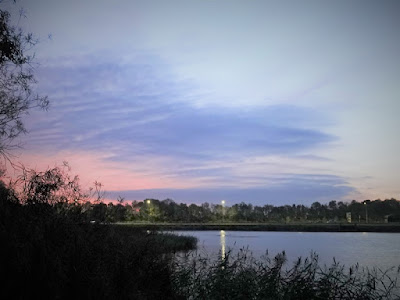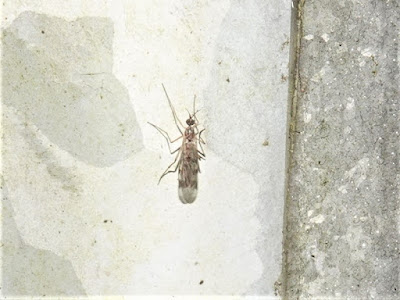6.0°C > 10.0°C: Mainly thin high cloud again. Somewhat stronger sun than yesterday. Light easterly breeze increasing moderate. Very good visibility.
Sunrise: 07:39 BST
+ = my first sighting of this species at this site this year.
++ = new species for me at this site.
* = a species photographed today
*Highlight today was a flight of eight Egyptian Geese over the Balancing Lake. This is the largest number I have seen together of this goose in the UK. It would have been even more of a highlight had I not seen one yesterday.
Priorslee Balancing Lake: 05:50 – 09:20
(214th visit of the year)
Bird notes:
- Another day with a low number of Black-headed Gulls.
- I am not sure why there were so few Wood Pigeons migrating today - the conditions seemed suitable. Indeed apart from a group of 39 Redwings there was no real movement at all.
Counts of birds noted flying over:
- *8 Egyptian Geese together
- >28 Feral Pigeon: nine flew W; then nine (same?) followed by 15 and then four all flying East.
-7 Stock Doves: five flew East together; two flew South together
- 155 Wood Pigeons: of these 24 were in just two migrant groups flying South
- 14 Lesser Black-backed Gulls
- 1 Common Buzzard
- 47 Jackdaws
- 136 Rooks [NB: yesterday's total of 75 was omitted in error]
- 5 Fieldfare
- 52 Redwings: most in one group of 39
- 1 Pied Wagtails
- 1 Meadow Pipit
Warblers noted (the number singing in brackets):
- 1 (1) Cetti's Warbler
Counts from the lake area:
- 7 Canada Geese: a single arrived and stayed; six flew in and left after c.20 minutes
- 2 + 2 Mute Swan
- 1 (1♂) Gadwall
- 1 (1♂) Mallard
- 7 (3♂) Tufted Duck: flew off
- 1 (0) Goosander: briefly
- 5 Moorhens
- 139 Coots
- 2 Great Crested Grebes
- c.25 Black-headed Gulls
- *9 Herring Gulls
- *51 Lesser Black-backed Gulls
- 1 Kingfisher
On or around the street lamp poles at dawn:
Moths:
- 3 November Moth agg. (Epirrita dilutata agg.)
- 3 November Moth agg. (Epirrita dilutata agg.)
Other things:
- 1 plumed midge
- *1 winter cranefly Trichocera sp.
- *1 wood gnat Sylvicola sp.
- 1 Bridge Orb-web Spider (Larinioides sclopetarius)
- 1 probable spider from the Metallina genus
- 2 male harvestmen Leiobunum blackwalli
Noted later:
- 6 harvestmen Dicranopalpus ramosus/caudatus
- 1 harvestman Paroligolophus agrestis
- 1 plumed midge
- *1 winter cranefly Trichocera sp.
- *1 wood gnat Sylvicola sp.
- 1 Bridge Orb-web Spider (Larinioides sclopetarius)
- 1 probable spider from the Metallina genus
- 2 male harvestmen Leiobunum blackwalli
Noted later:
- 6 harvestmen Dicranopalpus ramosus/caudatus
- 1 harvestman Paroligolophus agrestis
Pre-dawn it looked rather threatening. Three lorries parked up in the Castle Farm Way lay-by.
Looking better and the lorries have gone!
Salmon pink sky in places presaging a much windier day.
The north-east part of the water sheltered by trees and looking calm.
I snapped these eight geese as they flew by in the distance. I needed the help of the camera to identify them. On the third bird from the left it is possible to see an extensive area of pale on both the under-wing and the inner leading-edge of the upper-wing. This means they must be Egyptian Geese.
An enlargement of two birds from a different shot. It is possible to make out the strange marking this species shows around its eye and also the darker neck collar. It is the only goose species that does not show any white around the tail area.
A sub-adult Herring Gull. I cannot see enough of the upper-wing to give an age to it.
A first winter Lesser Black-backed Gull with all the upper-wing feathers dark.
The same bird from underneath. I am surprised how little patterning shows on this bird. Normally the ends of all the feathers form dark lines along the underside.
A Carrion Crow. Just a hint of a few pale feathers in the wings. Some birds, especially after the annual moult, can have obvious white patches. Rooks never show white like this.
A Dunnock contemplating life on the dam.
One of the winter craneflies Trichocera sp.
Not too dissimilar one of the wood gnats Sylvicola sp.
(Ed Wilson)
------------------------------------------------------------------------------------------------------
The Flash: 09:25 – 10:45
(199th visit of the year)
Bird notes:
- on the edge of the island both the pair of Gadwall and the two Common Teal could just about be seen.
Bird(s) noted flying over here:
- 2 Jackdaws
- 2 Skylarks
Warblers noted:
None
Noted on / around the water:
- 24 Canada Geese: of these ten flew in together
- 3 Greylag Geese: flew in with Canada Geese
- 2 + 4 Mute Swans
- 1 (1♂) Gadwall
- *39 (23♂) Mallard
- 1 (1♂) all-white feral duck
- 2 (0♂?) Common Teal
- 30 (>13♂) Tufted Duck
- 47 brownhead Goosander
- 14 Moorhens
- 42 Coots
- *5 + 2 (1 brood) Great Crested Grebes
- 19 Black-headed Gulls
- 2 Lesser Black-backed Gull: first winters, together and briefly
- *2 Cormorants: one departed
- 1 Kingfisher
Noted on / beside the street lamp poles etc. around the water etc.:
Noted on / around the water:
- 24 Canada Geese: of these ten flew in together
- 3 Greylag Geese: flew in with Canada Geese
- 2 + 4 Mute Swans
- 1 (1♂) Gadwall
- *39 (23♂) Mallard
- 1 (1♂) all-white feral duck
- 2 (0♂?) Common Teal
- 30 (>13♂) Tufted Duck
- 47 brownhead Goosander
- 14 Moorhens
- 42 Coots
- *5 + 2 (1 brood) Great Crested Grebes
- 19 Black-headed Gulls
- 2 Lesser Black-backed Gull: first winters, together and briefly
- *2 Cormorants: one departed
- 1 Kingfisher
Noted on / beside the street lamp poles etc. around the water etc.:
Moths:
- 1 November Moth agg. (Epirrita dilutata agg.)
- 1 November Moth agg. (Epirrita dilutata agg.)
Other things:
- 1 harvestman Dicranopalpus ramosus/caudatus
- 1 harvestman Paroligolophus agrestis
Noted elsewhere around The Flash:
- 1 harvestman Dicranopalpus ramosus/caudatus
- 1 harvestman Paroligolophus agrestis
Noted elsewhere around The Flash:
Mammals:
- Brown Rat (Rattus norvegicus)
- Brown Rat (Rattus norvegicus)
Bees / wasps etc.:
- *Common Wasp (Paravespula vulgaris)
- *Common Wasp (Paravespula vulgaris)
Flies:
- *Blow fly Calliphora vicina
- *Blow fly Calliphora vicina
Hoverflies
- Marmalade Hoverfly (Episyrphus balteatus)
- Tapered Dronefly (Eristalis pertinax)
- Common Dronefly (Eristalis tenax)
- Marmalade Hoverfly (Episyrphus balteatus)
- Tapered Dronefly (Eristalis pertinax)
- Common Dronefly (Eristalis tenax)
Bugs:
- *Hawthorn Shieldbug (Acanthosoma haemorrhoidale)
- *Hawthorn Shieldbug (Acanthosoma haemorrhoidale)
Fungus:
- *Veiled Poisonpie (Hebeloma mesophaeum)
- *Brown Rollrim (Paxillus involutus)
- *Veiled Poisonpie (Hebeloma mesophaeum)
- *Brown Rollrim (Paxillus involutus)
A drake Mallard showing how it is done, skidding to a halt.
Unlike this less controlled arrival.
An adult Great Crested Grebe has a fish for junior.
Passes it over carefully.
Don't drop it!
Junior seems to have a firm grip on it but how to manoeuvre it to swallow it head-first?
It looks as if the adult is poking it round with its bill.
And now all lined-up...
...or not!
Try with another fish.
The adult seems able to reorientate it easily-enough.
"Have this one".
A sub-adult Cormorant dries its wings / takes the sun. Pity about the Alder cones obscuring the face.
Not many people look that closely to see how hairy Common Wasps (Paravespula vulgaris) are.
I do! Many web sites will tell you that bees are hairy and wasps are not. The site HERE tells it like it is: "Wasps actually do have tiny hairs all over their body, but they are generally too small to see with the naked eye". It does not explain why they are hairy though.
This is the Blow fly Calliphora vicina.
Here in all its glory(?). Identification is confirmed by the orange base to the wing; the orange anterior spiracle (by the base of the front leg); and the yellowish 'jowls' under the eye. (What did we do before digital cameras?)
A somewhat unusual angle to view a Hawthorn Shieldbug (Acanthosoma haemorrhoidale).
One of today's fungus. Not a 100% match on Obsidentify with Veiled Poisonpie (Hebeloma mesophaeum) the best option, looking good against other photos on the internet.
This large Brown Rollrim fungus (Paxillus involutus) was broken off and gave the opportunity to see the gill structure (gloves weather!).
The top surface is battered and not much to look at.
Plane of the day and probably the week and the month. It is, as yesterday, a twin-engined 10-seat AgustaWestland AW169 but built in 2018 when the company was known as Leonardo. The registration painted under cockpit OY-HOF means it is registered in Denmark. It is a long way to come in a helicopter that cruises at 175 mph.
The FlightRadar24 data tells me from where it has come but not to where it is going. Using the playback facility I know it went to near Milford Haven, then Aberporth, on to Waterford in Ireland, next to Cardiff Airport before returning to Humberside. A busy day. Uni-Fly, the operator, is based at Hans Christian Andersen Airport at Odense. It specialises in wind-farm support operations.
(Ed Wilson)
------------------------------------------------------------------------------------------------------
On this day can be found via the yearly links in the right-hand column.
Sightings from previous years without links are below
2012
Priorslee Lake
1 Shoveler
3 Wigeon
12 Pochard
1 Little Grebe
(John Isherwood)
2008
Priorslee Lake
182 Wood Pigeons
10 Skylarks
(Ed Wilson)
2006
Priorslee Lake
16 Pochard
84 Tufted Ducks
1 Ruddy Duck
1 Kingfisher
21 Wrens
11 Dunnocks
38 Robins
22 Blackbirds
9 Song Thrushes
139 Redwings
30 Starlings
3 Redpolls
(Ed Wilson)




































